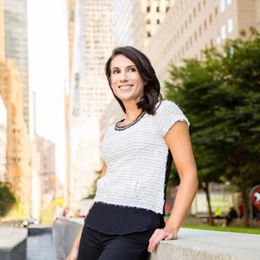The Real Cost of Being a Millennial Caregiver
Because care can't wait, and no caregiver should have to go bankrupt to care for a loved one
Editor's Note: This story is part of Caregiving In America: The 24/7 Caregiver, a Next Avenue initiative supported by The John A. Hartford Foundation.
In 2009, after graduating from college, I thought my first job would be doing something related to the political science and criminology degrees I had worked so hard to earn. But just four years after I set my sights on becoming a lawyer, I landed a different kind of role, one that, at the time, I never knew existed: I became a millennial family caregiver to my grandmother.
Fast forward more than a decade later, and I'm now in good company with an estimated 10 million millennial caregivers out there, according to AARP, a number that, by my estimates and those tracking these kinds of metrics, is only going to grow as 10,000 Baby Boomers turn 65 every day, a trend that will continue until the last one reaches that milestone in 2029.

My Journey to Caregiving
When I returned home to my native Long Island, New York after college, seeing my grandmother, who lived less than an hour away in a 55+ retirement community, instantly became a part of my weekly routine.
My in-person visits were equal parts companionship and care but were 100% time well spent.
As an only child, my grandmother and I have a special bond that makes talking numerous times a day feel natural. As an adult, my in-person visits were equal parts companionship and care but were 100% time well spent.
Naturally, as my grandmother continued to age, my visits began to center around taking her to doctor's appointments, helping her with grocery shopping, and driving her where she needed to go as she began to feel less comfortable behind the wheel.
We became such frequent fixtures at her local King Kullen that on more than one occasion, a fellow shopper asked me what home health care agency I worked for and if I was available for hire.
When The Caregiver Gets Cancer
The last thing I ever expected to hear when I went to my gynecologist for my annual exam in April 2013 at age 26 was that I had thyroid cancer. Yet, it was a routine neck check that my gynecologist performed that uncovered the nodule on the right side of my thyroid.
At the time, I had no signs or symptoms that anything was wrong and thought my only hurdle in life was figuring out my career path. Weeks passed as I underwent blood work, a neck ultrasound, and a fine need aspiration (FNA) biopsy, which confirmed the papillary thyroid carcinoma diagnosis.
The last thing I ever expected to hear when I went to my gynecologist for my annual exam in April 2013 at age 26 was that I had thyroid cancer.
By June, I had undergone a total thyroidectomy, had my lymph nodes removed, and started taking a daily synthetic thyroid hormone replacement pill that would remind me every day for the rest of my life that I was a survivor.
My experience with cancer in my twenties led me to become a Board-Certified Patient Advocate and to create a lifestyle and wellness blog called Living in Steil, where I share my cancer journey, offer resources and hopefully inspire other young patients and survivors.
Shortly after navigating my cancer diagnosis, my grandmother, who was 86 and already a twenty-year breast cancer survivor, was diagnosed with Paget's Disease, a rare form of breast cancer. She underwent a mastectomy and needed round-the-clock care at home, which I provided by taking a leave of absence from work until she healed.
Navigating My Career as a Cancer Survivor and Caregiver
I've always felt that being a caregiver to my grandmother was the greatest honor and privilege, especially as her granddaughter. But it came at a cost that many women face as they lose an estimated $324,044 in wages, pensions, retirement funds and benefits due to caregiving, according to the Family Caregiver Alliance. That cost to me was my career.
My biggest fear as a caregiver was coming true — my grandmother would spend her final days in a nursing home.
Since landing my first job out of college, I've always required flexibility and was conscious that would only be acceptable to some employers.
I was strategic when accepting and changing jobs and was used to explaining my caregiving circumstances to prospective employers. Most were understanding and willing to work with me.
Still, after more than a decade of caregiving, as my caregiving duties expanded, I decided to leave the workforce in 2022 to start my consulting agency where I could control my schedule and hours.
Caregiving 2.0
When I began my caregiving journey, I was in my twenties and admittedly knew little about long-term and end-of-life care. At one point, I had accompanied my grandmother to an estate planning attorney when she wanted to update all of the necessary legal documents a person needs as they age — a will, living will, health care proxy and power of attorney. I never thought about those documents again until I needed them for her care in late 2021.

After my grandmother complained of debilitating back pain, I took her to her primary care physician, who, upon exam, recommended she go for an x-ray. Unfortunately, her pain was so severe that the Emergency Room became the next logical step. Once there, we spent the better part of a day waiting to get her checked in to be evaluated and finally admitted.
The final report was pain from frail bones, old age and cognitive decline. Finally, she was recommended to go to a sub-acute rehabilitation facility to see if she could regain strength and continue living independently. Sadly, her first night at the sub-acute facility resulted in a fall and broken hip, followed by surgery and another week-long stay in the hospital.
By the time we were ready to leave the hospital for the second time, three weeks had passed, the cognitive decline had progressed, and it was recommended that she be moved to a long-term care facility, as she would surely not be able to live alone and was no longer ambulatory to be considered for assisted living.
My biggest fear as a caregiver was coming true — my grandmother would spend her final days in a nursing home, something I had always promised would never be in her future.
The Transition To Long-Term Care
In two months, my grandmother had gone from living independently in her condo of 20 years to someone who needed round-the-clock nursing care. As her granddaughter, it was a hard and fast decline to watch, but as her caregiver, I needed to figure out how best to help her with this transition and how to pay for her care, which came to more than $15K a month.
Unfortunately, my grandmother was only on Medicare, and as I soon learned, Medicare does not pay for long-term care, which meant I had to pay privately by dwindling all of her assets. After six months, I had successfully spent all of her liquid cash, which meant now I would have to sell stocks and put her condo on the market.
Society needs to normalize caregiving conversations, focusing less on the end of life and more on quality of life.
After another six months, her accounts had a zero balance, the condo had been sold, all of the proceeds were spent on her care, and I hired an elder care attorney to apply for Medicaid on my grandmother's behalf. I spent over $300,000 on her care in just one calendar year.
In addition to my role's financial and legal ramifications, I visited my grandmother nightly at dinnertime to help make her long-term care setting feel more familiar. I've spent over 700 nights with her, seldom giving myself a break to ensure she is okay.
Unfortunately, we've had numerous setbacks with COVID lockdowns that prevented my visits, another fall that resulted in a broken hip, and even some time in isolation.
Since my grandmother's transition in October 2021, I haven't turned off or silenced my phone, I've been awakened more times in the middle of the night than I can count, and I've had to wear many hats as a pseudo-social worker, pharmacist, nurse, attorney and the list goes on.
The Current Caregiving Crisis Explained
My experience as a sole family caregiver is not unique. I've come across many millennials in similar shoes to mine whose stories sound all too familiar yet often go unheard by those who can't relate. I only learned about the current caregiver shortage when I needed care for a loved one.
But with more professional caregivers leaving the profession due to long hours and little pay, being able to have your loved one age in place at home is becoming a distant memory.
This means that more unpaid and untrained family caregivers who may also be navigating caring for children, themselves and a career will need to step into these roles to pick up the slack whether they are physically or financially able to.
You know the adage, 'You don't know what you don't know?' Well, it's true in caregiving, too. When I first stepped into the role of caregiver, I had no idea what a person needed at the end of their life. I didn't understand the discussions that needed to happen so your loved one could have a dignified last chapter in their story.
And I certainly had yet to learn about the financial toll caregiving would take on me and my grandmother's finances. AARP recently shared new data highlighting the value of caregivers. Their findings noted that millions of unpaid family caregivers provide 36 billion hours of care annually, valued at $600 billion dollars.
Society needs to normalize caregiving conversations, focusing less on the end of life and more on quality of life. We also need to better care for both professional and family caregivers in terms of respect and compensation. Because care can't wait, and no caregiver should have to go bankrupt to care for a loved one.

After a decade of being a patient and a caregiver, Vanessa noticed two things: people don’t know what they don’t know, and patients need to be their own advocates. This realization led her to co-found The Hospital Bar, a community for caregivers of all kinds.
She is also the founder and CEO of In Steil Creative, a boutique communications agency. Read More

